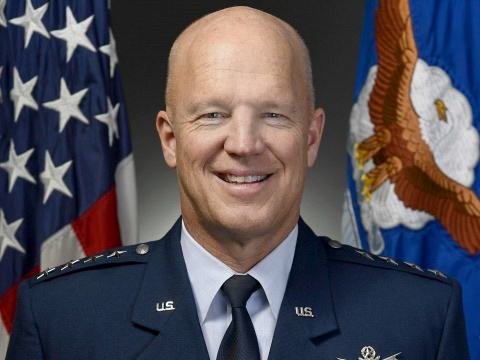Outside the Kendeda building on Monday, two identical black Chevy Suburbans with government plates were parked in the bus lane, underscoring the fact that a high ranking federal official was inside. That official was the sole member of the newly formed United States Space Force, General Jay Raymond, formerly of the Air Force. Raymond is also a member of the Joint Chiefs of Staff, one of the highest ranking bodies in the armed forces.
Raymond spoke at the Kendeda building, giving a nearly hour long lecture about the formation of the Space Force, and what the service will do going forward. The lecture, titled “Space as a Warfighting Domain”, began with a video, where soldiers reenacted a drone strike on a target in the “middle east”, although the video was recorded at a base in Colorado. The video ended with a question, “what would we do without space?” intended to underscore that the Space Force is supposed to be an important component of the armed forces.
The General then delved into the organizational structure that had been created, describing how the Space Force and the Air Force were related in a similar way as the Navy and Marine Corps are related. Both the Air and Space Forces are under the auspices of the Secretary of the Air Force, much as the Navy and the Marines are under the Secretary of the Navy.
This also applied to the warfighting commands that operated in the environment of space. They were taken out from underneath other commands and elevated to a more important station. One of the new warfighting bodies created along with the Space Force was a coalition force of countries such as Canada and the United Kingdom who have also elevated their own national space services.
Over the course of the lecture, Raymond underscored that one of the central jobs for the previous Space Command, and the current Space Force, will be the tracking of space debris and satellites so as to manage the orbital traffic and ensure that no objects are colliding with each other. Part of this job was underscored when the General asked if any of the students in the audience were studying data science, as big data analytics and data visualization is a key part of the Space Force’s purview. He went on to joke that he would “hire you on the spot” if you were pursuing that particular course of study, met with laughs from the students present.
Another point highlighted by General Raymond was the growing gap between private space exploration companies and the federal government’s own efforts. He related an anecdote of a tour of a SpaceX factory with Elon Musk, where the billionaire had no machines in the building, only tape on the floor indicating where they would go. Within four months, according to the General, the factory was fully operational and had produced around 60 satellites.
This was contrasted later in the lecture by Raymond’s assertion that to procure a satellite identical to an existing one would take nearly six years through the current federal processes, which he used to highlight how private industry was one of the new driving forces in the race for space technology.
He illustrated this through a brief discussion of SpaceX’s Starlink satellite constellation, as well as how they had automated many of the safety procedures surrounding rocket launches, a technology that was beginning to be adopted by the armed forces.
One of the key points that Raymond underlined in his lecture was the shift of space from a benign environment to one in which conflicts could reasonably be fought between state actors. This grew out of the fact that in 2007 China blew up one of their own satellites with a rocket, which
served as an alarm for the US armed forces, and spurred the creation of the US Space Command, a warfighting group within the armed forces that was tasked with the tracking and operation of the satellites of the US armed forces.
General Raymond opened the floor for questions following his lecture, letting students ask about the direction of the Space Force.
Students asked about things such as how the Space Force would limit its environmental impact, and how one could get involved with the organization. The service has been the butt of countless jokes online, from the fact that its logo is reminiscent of that of Star Trek’s Starfleet, to their likely use of existing camouflage uniforms despite the lack of foliage in space.
